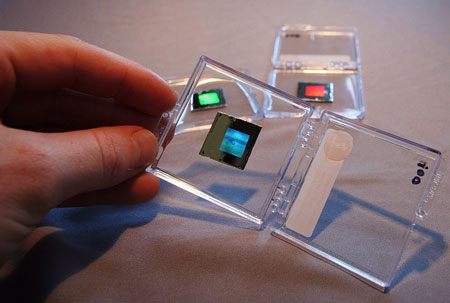| Jan 18, 2011 |
Butterfly wings behind anti-counterfeiting nanotechnology
|
|
(Nanowerk News) Imagine a hole so small that air can't go through it, or a hole so small it can trap a single wavelength of light. Nanotech Security Corp., with the help of Simon Fraser University researchers, is using this type of nano-technology – 1,500 times thinner than a human hair and first of its kind in the world – to create unique anti-counterfeiting security features.
|
|
The technology is first being applied to banknotes but it also has many more practical applications, such as authenticating legal documents, retail merchandise, concert tickets, stock certificates, visas, passports, and pharmaceuticals.
|
|
SFU applied sciences grad Clint Landrock started the initial research into nanoholes under the guidance of SFU engineering science professor Bozena Kaminska. When the pair pitched their idea to Doug Blakeway, SFU Venture Connection's entrepreneur in residence and also CEO and chairman of Nanotech, he was immediately intrigued by the technology's potential.
|
 |
| Nanotech Security Corp.'s new anti-counterfeiting product, N.O.t.E.S., will replace holograms used on banknotes and to authenticate items such as legal documents, visas, passports, and retail merchandise.
|
|
"I love nanotechnology but I really have not seen a commercialization of it that can make you money in the near term," said Blakeway. "When this was initially presented to me by Bozena and Clint, I immediately saw their vision and they were only after one application – creating anti-counterfeiting features for banknotes. I felt this could be the first commercial application of nanotechnology in the world. I kept thinking of applications for it and how it could be used; the technologies and potential astound me."
|
|
Landrock and Kaminska both continue their work as part of Nanotech's scientific team. The company's Nano-Optic Technology for Enhanced Security (NOtES) product stems from an idea originating in the purest form of nature – insects using colorful markings to identify themselves.
|
|
How this works is microscopic gratings composed of nanostructures interact with light to produce the shimmering iridescence seen on the Costa Rican morpho butterfly. The nanostructures act to reflect and refract light waves to produce the morpho's signature blue wings and absorb other unwanted light.
|
|
The highly advanced wing structures are the result of many millennia of evolution, and only recently have Nanotech's scientists discovered how to reproduce these structures reliably. While others have talked about the possibility of re-creating it, Nanotech has made this a reality.
|
|
The U.S. Treasury, which produces up to 11 billion banknotes annually, is a potential customer for Nanotech's product. The new U.S. $100 bill, designed with state-of-the art security features, was supposed to be introduced in February 2011 but it's been delayed due to some manufacturing issues.
|
|
Banknotes contain several security features – some that you can plainly see and some that only machines can read – such as hologram strips, security threads woven into the paper, watermarks, color-shifting inks, raised type, and UV inks.
|
|
According to Blakeway, Nanotech's product – which has attracted the attention of treasuries internationally – is superior to holograms and can't be duplicated.
|
|
"Nobody has ever done this," he said. "We have succeeded while everybody is still trying to duplicate or imitate a butterfly's wing because it absorbs light and gives off the color. There's no color pigment – there's nothing like a dye or anything else. It's a hole that traps light and releases color.
|
|
"You can't copy or scan it in, you can't inkjet it on paper, you can't do any of these things. It's extremely sophisticated and expensive to make the shims and dyes to produce, but very inexpensive to produce it at the end. Anywhere you can think of where a hologram is being used today, our technology can replace it. It's more secure than a hologram. You can't lift it off – we can put it onto metal, plastic, or paper."
|
|
SFU Venture Connections offers training and support programs for SFU entrepreneurs. It links students, faculty and local entrepreneurs with experienced advisors and funding opportunities.
|

